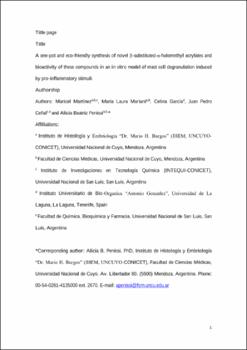A one-pot and eco-friendly synthesis of novel β-substituted-α-halomethyl acrylates and bioactivity of these compounds in an in vitro model of mast cell degranulation induced by pro-inflammatory stimuli.
Date
2023Abstract
The main goal of the present work was to develop new compounds derived from βsubstituted-α-halomethyl acrylates from a methodology in an aqueous phase and to evaluate their bioactivity as potential inhibitors of mast cell activation. Adult male Wistar
rats (n=205) were used. Mast cells were obtained by peritoneal lavage and purified in a discontinuous gradient of Percoll. Compound 48/80 (10 µg/ml) and the calcium ionophore A23187 (0.12 µg/ml) were used as mast cell secretagogues. Different concentrations of the 11 synthetic drugs (10 to 320 μM) were used. The release of βhexosaminidase was quantified as a marker of mast cell activation. Mast cell morphology
was evaluated by light and electron microscopy. Comparison studies with a reference compound, sodium chromoglycate, were also made. EC50 was calculated. Statistical analysis: ANOVA-1/Tukey-Kramer. Enzymatic release under basal conditions showed
values below 10 %. Compounds 48/80 and A23187 significantly stimulated the release of β-hexosaminidase from mast cells. The effect induced by compound 48/80 was inhibited by compound 5 (320 µM) and compound 9 (160 and 320 µM) without causing
cytotoxic effects. The effect induced by A23187 was inhibited by compound 5 (40, 80, 160, and 320 µM) without affecting cell viability. The inhibitory effects exhibited by compounds 5 and 9 were more potent than that of the reference compound. The biochemical results were consistent with the morphological findings. This study reports, for the first time, that the new synthetic compounds methyl (Z)-2-bromo-3-(furan-3-yl)acrylate (compound 5) and methyl (E)-2-bromo-3-(3-bromophenyl)acrylate
(compound 9) strongly inhibit mast cell degranulation, without affecting cell viability. The implications of these results are relevant as a basis for developing new antiinflammatory and mast cell stabilizing drugs.






